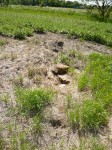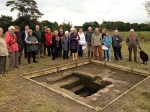 A medieval holy well in the village Rainhill, in Merseyside, England, used for centuries by pilgrims for its reputed miraculous healing powers, has been recovered after decades of neglect. The location of St. Anne’s Well was known, but after decades of ploughing in the surrounding fields, it had filled up with soil and was marked only by a couple of rocks perched on a patch of half-dead grass. In danger of disappearing from the landscape all together, six years ago it was placed on the Historic England’s Heritage at Risk Register. Earlier this year, Historic England commissioned Oxford Archeology North to excavate the site and find out what was left.
A medieval holy well in the village Rainhill, in Merseyside, England, used for centuries by pilgrims for its reputed miraculous healing powers, has been recovered after decades of neglect. The location of St. Anne’s Well was known, but after decades of ploughing in the surrounding fields, it had filled up with soil and was marked only by a couple of rocks perched on a patch of half-dead grass. In danger of disappearing from the landscape all together, six years ago it was placed on the Historic England’s Heritage at Risk Register. Earlier this year, Historic England commissioned Oxford Archeology North to excavate the site and find out what was left.
Two days of digging revealed a shallow well 5’9″ square and four feet deep constructed of local ashlar sandstone blocks with a level stone floor and three steps lead down to the water basin. There is a thin layer of water at the bottom of the well even now. A stone conduit on the north side of the well which once carried overflow water from the well to a carved stone basin is no longer extant. Also missing is a medieval carved relief of a woman carrying a pitcher that was last recorded on site in the mid-19th century when the well was still in use.
While there doesn’t seem to be an explicit association of St. Anne, mother of the Virgin Mary, with water or wells in Catholic or Orthodox traditions, in England many waters believed to have healing powers were dedicated to her. Veneration of sacred springs, wells and fonts was a common in pre-Christian religions, so it seems likely the powers of earlier divinities or forces were mapped on to Anne in the late Middle Ages when her cult became increasingly popular. The wells were sometimes said to have been visited by an apparition of St. Anne who bathed in the waters rendering them miraculous; other times her image appeared in the water or structure of the well, like Jesus on a potato chip.
 In the Middle Ages and Renaissance, the Rainhill St. Anne’s Well had a reputation for specializing in the treatment of skin diseases. Pilgrims seeking healing would walk down the steps and dip into the water that naturally filled the basin, seeping in from below the stone floor. The faithful who sought aid from the healing waters would leave offerings, from the simple (crutches, shirts) to the rarefied (gold coins), another practice long predating Christianity. As the holy well became a greater and greater draw, Sutton Priory, the monastery about a mile away which owned the well, had a small three-room house built over the well. Two of the priory monks lived in the house to tend to the well, the pilgrims and their gifts.
In the Middle Ages and Renaissance, the Rainhill St. Anne’s Well had a reputation for specializing in the treatment of skin diseases. Pilgrims seeking healing would walk down the steps and dip into the water that naturally filled the basin, seeping in from below the stone floor. The faithful who sought aid from the healing waters would leave offerings, from the simple (crutches, shirts) to the rarefied (gold coins), another practice long predating Christianity. As the holy well became a greater and greater draw, Sutton Priory, the monastery about a mile away which owned the well, had a small three-room house built over the well. Two of the priory monks lived in the house to tend to the well, the pilgrims and their gifts.
Sutton Priory was small in population, having about a dozen monks, but large in income. Besides the well, which by the 16th century was very lucrative, it owned the valuable surrounding farmland which it leased to moneyed members of the gentry. A boundary dispute between the priory and its neighbor Sir Richard Bold would transform the holy well into a cursed one.
The legend of how the holy well became the locus of a curse was recounted in the St. Helens Leader (pdf), the journal of the local YMCA, in 1877. Hugh Darcy, Bold’s steward met Prior Delwaney and traded harsh words with him. Darcy sneered that maybe the prior wouldn’t be a prior a much longer. The year was 1536, and one or two days after that tense exchange, Layton and Leigh, agents of Thomas Cromwell charged with the Dissolution of the Monasteries, notified Delwaney that Sutton Priory was to be no longer. All the monks were given a couple of pounds, a robe and packed off to another monastery (until that one too was dissolved), and the crown claimed all of the priory’s property, including the holy well.
When the prior and the crown’s agents went to the well, they found Dancy there, gloating. Delwaney became enraged at Dancy’s taunts and hissed: “The curse of the serpent be on thee, thou spoiler of the Lord’s inheritance. Thy ill-gotten gains shall not profit thee, and a year and a day shall not pass ere St. Anne thy head shall bruise.” Three hours later, Delwaney was dead. Dancy did fine at first, acquiring the farmland that included the well and demolishing the house over it. But within months his only son was dead, his lost his money in dubious investments and he took to drinking heavily. One night, after an evening of imbibing at the tavern, he failed to come home. He was found dead the next morning, head smashed against the well.
The story of the curse and the loss of the priory didn’t stop people from seeking healing in the waters of St. Anne’s Well. It was in use into the 19th century, adding to its previous reputation one for healing diseases of the eye. It was captured in a sketch by naturalist and fossil-hunter Richard Owen in 1843, and it still had its basin and the relief of the lady with the pitcher. By 1877, however, when the St. Helens Leader article was written, the stones were broken, the water dried up and weeds grew unchecked.
 The well is on private property today, but Historic England has struck an agreement with the farmer to keep the well from getting clogged with dirt and disappearing again.
The well is on private property today, but Historic England has struck an agreement with the farmer to keep the well from getting clogged with dirt and disappearing again.
New wooden edging to the perimeter of the excavation will prevent soil falling in, and provide a buffer to protect the well from damage by farm machinery. It can now come off the Heritage at Risk Register.